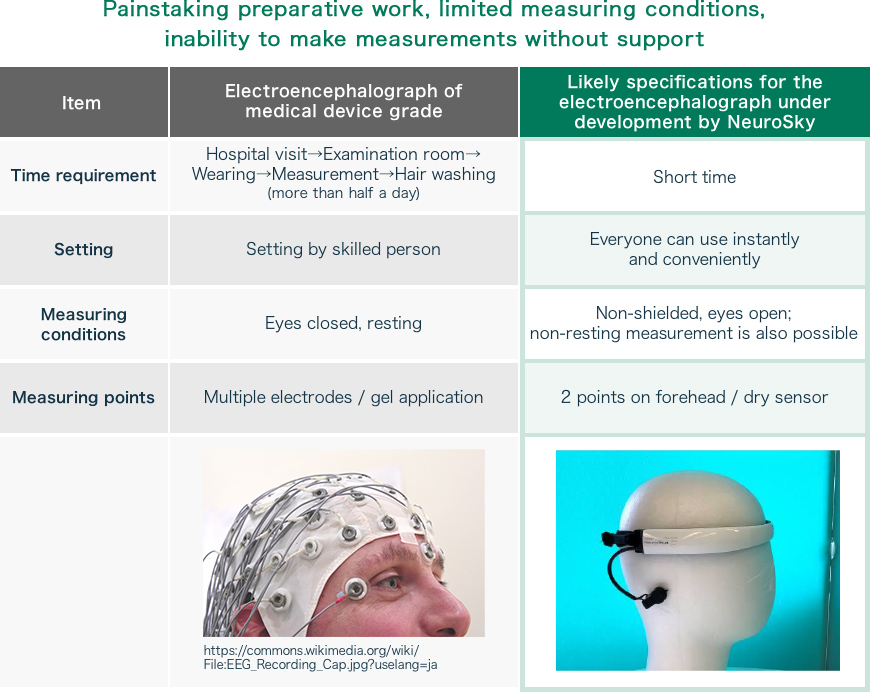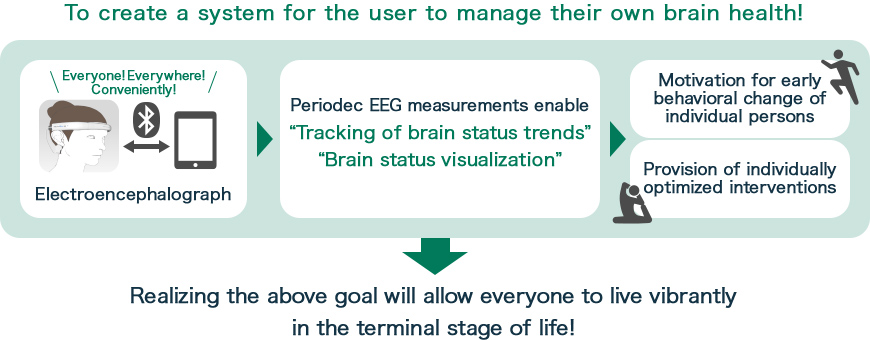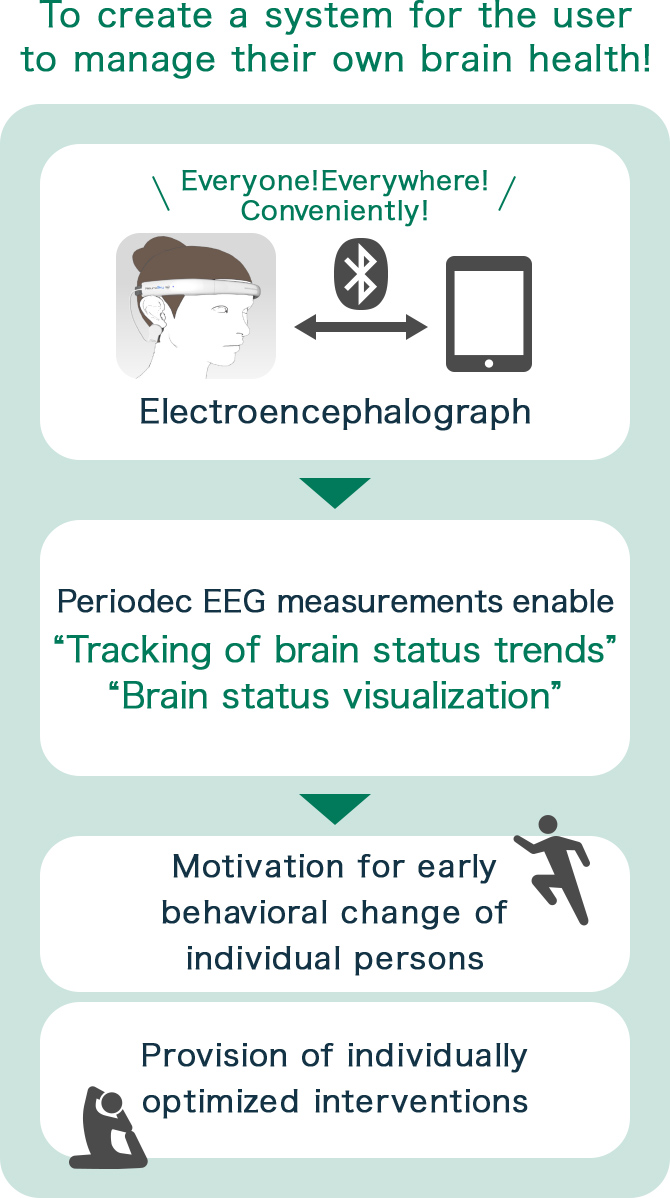NeuroSky Co., Ltd. (NeuroSky) has developed Electroencephalography (EEG) data acquisition technology for a broad range of applications, from healthcare to clinical services, using a simple electroencephalograph that enables EEG measurements by "Everyone! Everywhere! Conveniently!” The system enables easy assessments of EEG trends at home that are otherwise impossible.
NeuroSky was founded in 2012 as a Japanese subsidiary of NeuroSky, Inc., an American company based in Sun Jose, California. In 2018, it was spun off from the US headquarters as a joint venture between NeuroSky, Inc. and Japanese VC. Since its foundation in 1999, NeuroSky, Inc. has been engaged in the independent design and development of semiconductor chips for biosensing. Based on their technical resources, NeuroSky Inc. also design, develop, and manufacture EEG measuring systems, brain-machine interface (BMI) equipment, and toys.
This joint project aims to spread NeuroSky’s noise filtering technology to the general public. Nurtured through their healthcare and toy businesses, the unique technology enables us to sense EEG in daily life, with the quality of the “electroencephalograph of medical device grade" ensured by Sumitomo Dainippon Pharma Co., Ltd. by making the best use of their experience in healthcare and drug development.
Potential of EEG measurements using a biosignal sensor
Conventional electroencephalography at medical institutions


The duration of life that can be lived with no limitations on daily activities is known as the “healthy life expectancy.” Although Japanese people have recently been living longer than ever on average, their “healthy life expectancy” does not always equal their “average life span,” because of deterioration of the “body” and “mind,” as well as diseases and injuries. To live a vibrant life in senescence at the final stage of life, it is important that not only physical health, but also mental (brain) health be maintained.
Brain health cannot be maintained long without periodic measurements and monitoring of EEG. However, as NeuroSky chairman Kikuo Ito has said, “The use of tools has so far not spread so widely as to allow individual users to check their own brain health status.”
He continued, “EEG measurements are susceptible to environmental conditions and are difficult to handle. In clinical settings, the measurements are subject to a number of limitations, including the requirement that patients to be retained at rest and involvement of technical and other specialists. One electroencephalograph system sometimes costs up to several hundred thousand yen, and the measurements usually take a long time from preparation to completion in hospital settings. Self-measurement of EEG by the subject would offer great advantages.” (Kikuo Ito, Chairman of NeuroSky)
Goal to reach (social significance)


“Everybody! Everywhere! Conveniently!” - that’s NeuroSky’s mission. Hence, we aim to create a situation in which individual persons can measure their own EEG conveniently, without being influenced by environmental or other limitations. We are determined to enable everyone to measure their EEG just as they measure their body temperature and periodically weigh themselves during physical deconditioning to manage their health status.
Lower barriers to EEG measurements for periodic brain data acquisition would increase the feasibility of data linkage between general healthcare and clinical services. In addition, continuous tracking of the wearer’s brain status would allow the user, for example, to understand the impacts of their behaviors such as exercise, communication, and hobbies on their brain. These factors can be motivational for their activities and potentially allow them to identify the best personalized interventions for themselves.
Hence, EEG monitoring technologies would drive a world in which everyone can manage their own brain health. Brain health is key to living vibrantly in the final stage of life, and to extending one’s healthy life expectancy.
Products that have been developed by NeuroSky
Our US parent company, NeuroSky, Inc., began its business in the toy market, which lies in contrast to the medical services field. Their electroencephalogram-sensing technology emerged from research into driving radiocontrolled model cars by EEG, by means of electroencephalography.
Driving a radiocontrolled model car requires a sensor chip that enables EEG measurements to be obtained everywhere and noise-filtering technology to improve measurement data accuracy. Since its foundation in Silicon Valley in 1999, NeuroSky, Inc. has been working on this research for over two decades. Their R&D efforts have led to the EEG sensor module TGAM, based on signal processing technology and EEG analytical algorithms.
TGAM is a sensor that can be incorporated in headsets, hats, helmets, and hairbands. The acquired weak EEG signals are filtered to eliminate noise, then amplified and digitized. The system is also equipped with algorithms developed in-house and functions to display the levels of the user’s attention and meditation in real time.


The above photos show example products that have been developed with TGAM by NeuroSky. The left panel shows a wide variety of simple electroencephalography acquisition systems that have been developed over several versions since 2004.
The right panel shows a product marketed with the catchphrase “EEG-driven cat ears” becoming topical under the tradename “necomimi” in Japan, the United States, Europe, and elsewhere. The headset with cat-ear-shaped parts senses the wearer’s EEG; the ears move in synchronization with the levels of mental state such as attention and meditation nearly in real time. In addition, some other “EEG toys” controlled by means of EEG have been developed in collaboration with an American company, and are already on the market.
Hence, in the toy market, which lies in contrast to the medical services field, NeuroSky has developed many products making the best use of our EEG measurement technology. Based on the knowledge and findings thus compiled, in combination with Sumitomo Dainippon Pharma’s technical know-how in medical and pharmaceutical development, we are planning to develop an electroencephalograph of sufficient quality for a medical device.
What data can be acquired using the electroencephalograph?
Our electroencephalograph under development enables the user to acquire frontal EEG at the same level as with medical device electroencephalographs. Although what could be determined based on this information remains to be determined by research in the future, it is expected that new uses of EEG will be found in naïve areas with increasing availability of measurement.
Example possibilities include the identification of pathologic conditions that have not been identified objectively in the medical field, and converting invisible brain status, such as "desired brain function achieved as expected," into manipulable data in the healthcare and entertainment fields.
Essentially, EEG involve fluctuations due to environmental and personal factors. It is difficult to accurately determine the brain status merely by taking measurements at particular points; long-term brain trends can be monitored more accurately only through frequent obtainment of necessary data and recording them in chronological order, using an electroencephalograph.
Toward applications as a medical device in hospital settings
Electroencephalographs for use in clinical settings necessitate a hospital visit for each session of EEG measurement, which takes some 3 hours including preparative work. In contrast, the electroencephalograph being developed by NeuroSky based on new technology is wearable by everyone regardless of measurement place and other conditions. With regard to pricing, we are working to develop electroencephalographs that are less expensive than conventional products.
After acquiring approval for use as a medical device, NeuroSky will proceed to introduce our electroencephalograph to research institutions in Japan for investigational and other purposes. Thereafter, a EEG measurement system for healthcare purposes will also be launched as a non-medical device. Our goal to be attained several years later is that the innovative system will be used in combination with analytical algorithms in clinical settings, and that measured EEG will serve as healthcare data as they are.
In addition, at the Frontier Business Office of Sumitomo Dainippon Pharma Co., Ltd., we are endeavoring to conduct research and development for new value and business by combining our knowledge that has been compiled through R&D activities for pharmaceuticals for neuropsychiatric diseases and unique technologies, findings, and patents of our business partners. If you are interested in collaboration as our business partner, please contact us.